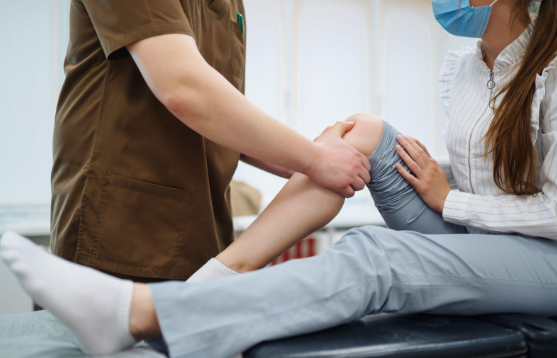Complex Regional Pain Syndrome: What It Is and How It’s Treated

Picture it: you recently received a nasty cut to the arm. You treat the cut as you would any other, but then you notice that even the slightest touch near the cut over the next couple of days causes severe pain, far more than you would think normal for a cut that big or small. This feeling stays around, even months after the cut has healed.
This might be an instance of Complex Regional Pain Syndrome.
What Is Complex Regional Pain Syndrome?
Complex Regional Pain Syndrome, or CRPS, is a condition that can be difficult to understand. In the past, it was referred to both as reflex sympathetic dystrophy (RSD) and causalgia, but now more is known about this condition. Simply put, CRPS is an overarching term that refers to excess and prolonged pain and inflammation that follow an injury to an arm or leg. There are two forms, one of which is acute (short-term) and the other chronic (where it lasts longer than six months or half a year). This pain can be debilitating to the point where you might not even be able to use the extremity you are experiencing it in.
In order to fully understand CRPS, let's first take a look at how it manifests so you will know what to look out for following an arm or leg injury.
What Are the Symptoms of CRPS?
The reason this condition is difficult to understand is that there can be a range of pain symptoms, anything from spontaneous pain or excess pain that is far greater than normal following a mild touch or brush of the extremity. CRPS can also be accompanied by changes in temperature, skin color, and even swelling below the site of the injury.
CRPS happens in extremities such as the arm or the leg, and while it typically improves as time goes on to the point that it often goes away, in some cases it lingers or is more severe, making it quite debilitating.
What Causes CRPS?
One of the most frustrating things about CRPS is how it can affect some people with the same injuries as others while not affecting the other injured parties as well. Because of this, there is no real known “cause” for CRPS, but it presents itself after the sufferer has received an injury to an extremity. Researchers have realized the cause is due to the dysfunction of or damage to the injured peripheral sensory neurons through this correlation.
The nervous system is composed of the brain and spinal cord, and the peripheral nervous system makes the nerve signals from the brain and spinal cord spread to all other parts of the body. This means that, when the neurons are damaged or not functioning properly, the signal of severe pain is transmitted.
Pain is our body trying to warn us against dangers. These can be both external (pain from holding your hand too close to a fire) or internal (a headache). CRPS occurs when the nervous system is given incorrect information about the level of pain currently being experienced by the extremity, which can lead to acute or chronic bouts of extreme pain to the point where it becomes debilitating.
Most Common Injuries That Lead to CRPS
While it is unclear what causes CRPS, certain injuries are more commonly paired with it than others:
● Fractures. When dealing with wrist fractures especially, the nerves can become injured. Add to that a cast that’s too tight, and CRPS might come about. Casts that are painful or too tight to wear should be immediately replaced because of this.
● Surgery. Due to the nature of surgery—needing to get into the body in a way that is not natural, such as a surgical incision, and even the presence afterward of sutures—the nerves can get damaged, which in turn will bring about CRPS. Even if the surgery itself goes perfectly fine, CRPS can still pop up because of the nerve damage.
● Sprains/strains. Even if the injury is internal, CRPS can come along. This is due to the fact, during a sprain or strain, the connective tissue ruptures, leading to trauma and excess movement that can stretch nearby nerves and cause damage and dysfunction of the neurons.
● Lesser injuries such as burns or cuts. Similar to the small incisions needed sometimes for surgery, smaller injuries can also cause CRPS. So long as the nerves that are just underneath are damaged, no matter how big or little the burn or cut, CRPS can be activated.
How Is CRPS Treated?
While CRPS might seem scary, there are ways to go about treating it. Methods have been used before that have been proven ineffective, but now that medical professionals have done more research on the causality of CRPS, it can be treated more effectively. Here are some of the more common—and effective—ways used to treat CRPS today:
● Physical Therapy: Through physical rehabilitation, the symptoms of CRPS can be managed, and the risk of long-term physical problems can be avoided.
● Pain Management: Treating the pain itself can be done by a medical professional, to the point where excessive bouts of pain from CRPS can be made much more tolerable. A procedure such as wireless peripheral nerve stimulation is one way pain can be managed.
● Spinal Fluid Drug Pumps: Due to the nature of the nervous system, those with chronic pain, such as those with CRPS, can be treated with pain pumps. The pump directly provides pain medication to the spinal fluid, which in turn can be sent along the nervous system so that sufferers can find relief.
What Should I Do if I Think I Have CRPS?
The best thing to do if you think you might be suffering from CRPS is to consult a medical professional. At PTCOA, we can help diagnose you so that the root cause of your pain can be found and treated, letting you get back to normal that much quicker. This can be done through a detailed examination and procedures such as imaging nerves by ultrasound or MRI (magnetic resonance imaging), along with a few more, to help find the region that is fully affected by CRPS and treat it properly.
Pain Treatment Centers of America has the most combined pain management experience of any practice in the region, including helping those who experience CRPS. Call us at (844) 215-0731 or visit our website today to learn more about how we can help.













